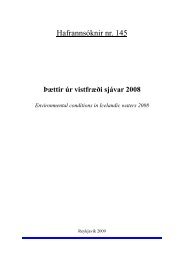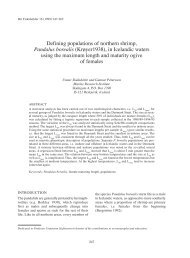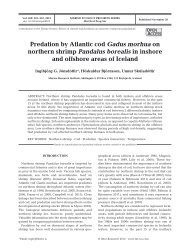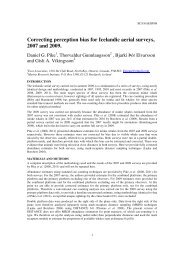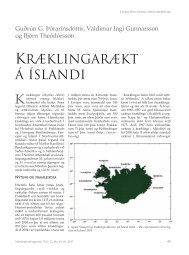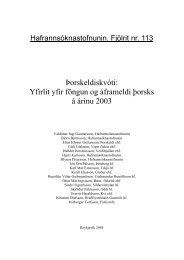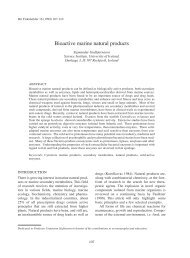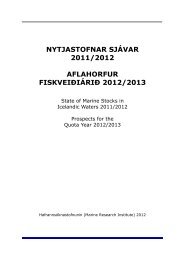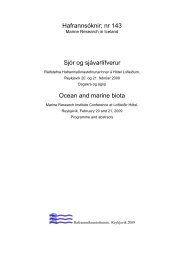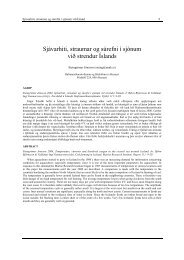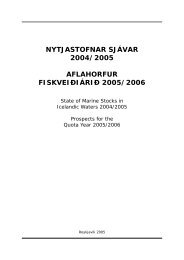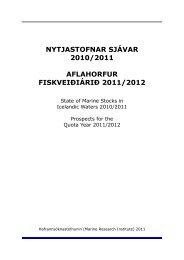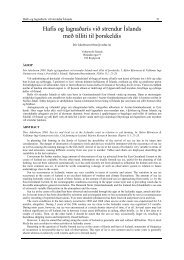Fishes of the suborder Ceratioidei (Pisces: Lophiiformes) in ...
Fishes of the suborder Ceratioidei (Pisces: Lophiiformes) in ...
Fishes of the suborder Ceratioidei (Pisces: Lophiiformes) in ...
You also want an ePaper? Increase the reach of your titles
YUMPU automatically turns print PDFs into web optimized ePapers that Google loves.
Rit Fiskideildar 16 (1999) 197-207<br />
<strong>Fishes</strong> <strong>of</strong> <strong>the</strong> <strong>suborder</strong> <strong>Ceratioidei</strong> (<strong>Pisces</strong>: <strong>Lophiiformes</strong>)<br />
<strong>in</strong> Icelandic and adjacent waters<br />
Gunnar Jónsson and Jónbjörn Pálsson<br />
Mar<strong>in</strong>e Research Institute<br />
Skúlagata 4, P.O. Box 1390<br />
IS-121 Reykjavík, Iceland<br />
ABSTRACT<br />
Distribution <strong>in</strong> Icelandic waters is described for Caulophryne jordani (Caulophrynidae),<br />
Melanocetus johnsoni (Melanocetidae) , Himantolophus alb<strong>in</strong>ares, H. groenlandicus, H. mauli,<br />
H. melanophus (Himantolophidae), Chaenophryne draco, C. longiceps, Dolopichthys longicornis,<br />
Oneirodes anisacanthus, O. carlsbergi, O. eschrichtii, O. macrosteus, O. myrionemus<br />
(Oneirodidae), Ceratias holboelli, Cryptopsaras cousei (Ceratiidae), Gigantactis ios, G. vanhoeffeni<br />
(Gigantact<strong>in</strong>idae), L<strong>in</strong>ophryne algibarbata, L. coronata and L. lucifer (L<strong>in</strong>ophrynidae).<br />
In relative terms, H. groenlandicus, C. holboelli and C. cousei are considered “common”, H.<br />
mauli, C. draco, C. longiceps, O. eschrichtii and L. lucifer “relatively common”, but o<strong>the</strong>r species<br />
“rare”.<br />
Keywords: Ceratioid fish, Icelandic Waters, distribution.<br />
INTRODUCTION<br />
Seventy five years ago only three species <strong>of</strong><br />
Ceratioid fish were known from Icelandic<br />
waters. The first species reported was Himantolophus<br />
groenlandicus, when one specimen was<br />
found <strong>in</strong> <strong>the</strong> harbour <strong>of</strong> Vestmannaeyjar <strong>of</strong>f <strong>the</strong><br />
south coast <strong>of</strong> Iceland <strong>in</strong> 1886 and ano<strong>the</strong>r <strong>in</strong><br />
1901 (Sæmundsson 1909). Ceratias holboelli<br />
was reported for <strong>the</strong> first time <strong>in</strong> 1914 <strong>of</strong>f <strong>the</strong><br />
western south coast (Selvogsbanki), and <strong>the</strong> first<br />
Cryptopsaras couesi was found <strong>in</strong> <strong>the</strong> harbour<br />
<strong>of</strong> Vestmannaeyjar <strong>in</strong> 1914 (Sæmundsson 1922).<br />
Dur<strong>in</strong>g <strong>the</strong> first half <strong>of</strong> this century, fish<strong>in</strong>g<br />
vessels such as trawlers were operat<strong>in</strong>g <strong>in</strong> <strong>the</strong> relatively<br />
shallow waters <strong>of</strong> <strong>the</strong> Icelandic shelf. Dur<strong>in</strong>g<br />
this time, Ceratioid fish were rare f<strong>in</strong>d<strong>in</strong>gs.<br />
When trawlers began to operate <strong>in</strong> deeper<br />
waters, fishermen encountered <strong>the</strong>se rare fishes<br />
<strong>in</strong> <strong>in</strong>creas<strong>in</strong>g numbers. Many fishermen are<br />
<strong>in</strong>terested <strong>in</strong> know<strong>in</strong>g what species <strong>of</strong> fish <strong>the</strong>y<br />
have found and <strong>the</strong>refore br<strong>in</strong>g <strong>the</strong> specimen<br />
ashore for identification. Although fishermen<br />
probably do this mostly to satisfy <strong>the</strong>ir own<br />
curiosity <strong>the</strong>y, naturally add to <strong>the</strong> knowledge <strong>of</strong><br />
<strong>the</strong> distribution and biology <strong>of</strong> rare fish species<br />
occurr<strong>in</strong>g <strong>in</strong> <strong>the</strong> waters where <strong>the</strong>y operate.<br />
S<strong>in</strong>ce 1967, a list <strong>of</strong> rare fishes, brought to<br />
<strong>the</strong> Mar<strong>in</strong>e Research Institute <strong>in</strong> Reykjavik, has<br />
been published annually <strong>in</strong> Ægir, a journal <strong>of</strong> <strong>the</strong><br />
Fisheries Association <strong>of</strong> Iceland (Jónsson 1967-<br />
1975; Jónsson et al. 1976-1997).<br />
Dedicated to Pr<strong>of</strong>essor Unnste<strong>in</strong>n Stefánsson <strong>in</strong> honour <strong>of</strong> his contributions to oceonography and education.<br />
197
Figure 1. The names <strong>of</strong> fish<strong>in</strong>g areas and o<strong>the</strong>r geographical locations<br />
mentioned <strong>in</strong> <strong>the</strong> text.<br />
MATERIAL AND METHODS<br />
This paper reports on <strong>the</strong> geographical distribution<br />
<strong>of</strong> known records <strong>of</strong> Ceratioid fish caught <strong>in</strong> <strong>the</strong><br />
waters around Iceland, south to 60°N. The names<br />
<strong>of</strong> fish<strong>in</strong>g areas and o<strong>the</strong>r geographical locations<br />
mentioned <strong>in</strong> <strong>the</strong> text are shown on Figure 1.<br />
Most <strong>of</strong> <strong>the</strong> specimens reported on were<br />
caught by commercial fish<strong>in</strong>g vessels and sent<br />
to <strong>the</strong> Mar<strong>in</strong>e Research Institute (MRI) <strong>in</strong> Reykjavik<br />
for identification. Information on catch<strong>in</strong>g<br />
date and location are <strong>of</strong> vary<strong>in</strong>g precision. Only<br />
specimens accompanied by relatively precise<br />
<strong>in</strong>formation on fish<strong>in</strong>g location, ei<strong>the</strong>r <strong>the</strong> location<br />
<strong>of</strong> <strong>the</strong> relevant tow or <strong>the</strong> fish<strong>in</strong>g ground<br />
where <strong>the</strong> vessel was operat<strong>in</strong>g,<br />
are <strong>in</strong>cluded on <strong>the</strong> distribution<br />
maps (Figs. 2-8). Specimens<br />
positioned more vaguely, e.g.<br />
“<strong>of</strong>f <strong>the</strong> south coast”, are<br />
counted <strong>in</strong> <strong>the</strong> total number<br />
recorded, but not shown on <strong>the</strong><br />
distribution maps.<br />
Fish<strong>in</strong>g grounds, referred to<br />
<strong>in</strong> <strong>the</strong> paper as <strong>the</strong> Víkuráll<br />
area, are located <strong>of</strong>f <strong>the</strong> nor<strong>the</strong>rn<br />
west coast <strong>of</strong> Iceland,<br />
approximately between 65°N<br />
and 66°N, from 28°W to 30°W.<br />
The depth is between 900 and<br />
1200 m and trawlers fish <strong>the</strong>re<br />
for Greenland halibut (Re<strong>in</strong>hardtius<br />
hippoglossoides) with<br />
bottom trawl.<br />
Fish<strong>in</strong>g grounds, referred to<br />
as <strong>the</strong> Reykjanes Ridge, are<br />
situated southwest <strong>of</strong> Iceland. In <strong>the</strong> more<br />
<strong>of</strong>fshore part <strong>of</strong> this area, as well as <strong>in</strong> <strong>the</strong><br />
Irm<strong>in</strong>ger Sea and <strong>the</strong> Iceland Bas<strong>in</strong>, trawlers fish<br />
for redfish (Sebastes mar<strong>in</strong>us and S. mentella)<br />
us<strong>in</strong>g midwater trawl (MWT) while bottom trawl<br />
is used <strong>in</strong> shallower waters. This commercial<br />
fish<strong>in</strong>g gear has a mesh size <strong>of</strong> 135-145 mm.<br />
Records <strong>of</strong> Ceratioid fish from Icelandic<br />
waters, reported on <strong>in</strong> Annales Biologiques<br />
dur<strong>in</strong>g 1953-1966 (German records <strong>of</strong> rare fish)<br />
as well as o<strong>the</strong>r published records cited <strong>in</strong> <strong>the</strong><br />
text, are <strong>in</strong>cluded <strong>in</strong> <strong>the</strong> distribution maps.<br />
If not o<strong>the</strong>rwise stated, all measurements<br />
given represent total length.<br />
Figure 2. Records <strong>of</strong> Caulophryne jordani and Melanocetus johnsoni <strong>in</strong> Icelandic waters. Depth contours are<br />
drawn for <strong>the</strong> 500 and 1000 m isobaths.<br />
198
Figure 3. Records <strong>of</strong> Himantolophus alb<strong>in</strong>ares, H. groenlandicus, H. mauli and H. melanophus <strong>in</strong> Icelandic<br />
waters. Dots may <strong>in</strong>dicate more than one record. Depth contours are drawn for <strong>the</strong> 500 and 1000 m isobaths.<br />
RESULTS<br />
CAULOPHRYNIDAE<br />
Caulophryne jordani Goode and Bean, 1896<br />
Five specimens have been recorded at <strong>the</strong> MRI,<br />
<strong>the</strong> first <strong>in</strong> June 1990. Three <strong>of</strong> <strong>the</strong> fish were caught<br />
with bottom trawl <strong>in</strong> <strong>the</strong> Víkuráll area at a depth<br />
<strong>of</strong> 900-1100 m, but <strong>the</strong> o<strong>the</strong>r two with midwater<br />
trawl operated at a depth <strong>of</strong> 600-700 m on <strong>the</strong><br />
Reykjanes Ridge (Fig. 2). The length <strong>of</strong> <strong>the</strong> specimens<br />
ranged from 13.5 to 21.5 cm, with an<br />
average <strong>of</strong> 17.8 cm. The first record was orig<strong>in</strong>ally<br />
reported by Oddsson (1991) as C. polynema, but<br />
on closer exam<strong>in</strong>ation was found to be C. jordani.<br />
MELANOCETIDAE<br />
Melanocetus johnsoni Guen<strong>the</strong>r, 1864<br />
In May 1996, one 17 cm specimen was caught<br />
with midwater trawl operated at a depth <strong>of</strong> 730-<br />
750 m <strong>in</strong> <strong>the</strong> NW Irm<strong>in</strong>ger Sea (62°50’N,<br />
30°35’W; Fig. 2) (Jónsson et al. 1997).<br />
HIMANTOLOPHIDAE<br />
Himantolophus alb<strong>in</strong>ares Maul, 1961<br />
Four specimens have been recorded, one caught<br />
with bottom trawl at 620-700 m depth on <strong>the</strong><br />
Reykjanes Ridge (62°40’N, 24°54’W) and three<br />
with bottom trawl <strong>in</strong> <strong>the</strong> Víkuráll area at a depth<br />
<strong>of</strong> 900-1100 m (Fig. 3). The length <strong>of</strong> <strong>the</strong>se fish<br />
was 20-25 cm with an average <strong>of</strong> 22 cm.<br />
Himantolophus groenlandicus Re<strong>in</strong>hardt, 1837<br />
A total <strong>of</strong> 91 specimens have been recorded at <strong>the</strong><br />
MRI. The distribution ranged from <strong>the</strong> Víkuráll<br />
area south to and west <strong>of</strong> <strong>the</strong> Reykjanes Ridge and<br />
from <strong>the</strong>re east along <strong>the</strong> south coast <strong>of</strong> Iceland to<br />
<strong>the</strong> Iceland-Faroe Ridge (Fig. 3). The size <strong>of</strong> <strong>the</strong>se<br />
fish ranged from 9-56 cm with average <strong>of</strong> 36 cm.<br />
199
Figure 4. Records <strong>of</strong> Chaenophryne draco, C.<br />
longiceps and Dolopichthys longicornis <strong>in</strong><br />
Icelandic waters. Dots may <strong>in</strong>dicate more than<br />
one record. Depth contours are drawn for <strong>the</strong><br />
500 and 1000 m isobaths.<br />
Himantolophus mauli Bertelsen and Krefft, 1988<br />
Eleven specimens have been recorded. The first<br />
was caught <strong>in</strong> May 1991 <strong>in</strong> MWT operated at a<br />
depth <strong>of</strong> 360-440 m <strong>in</strong> <strong>the</strong> Reykjanes Ridge area<br />
(62°42’N, 30°08’W). Fur<strong>the</strong>r 8 specimens were<br />
caugth by MWT on and west <strong>of</strong> <strong>the</strong> Reykjanes<br />
Ridge, while two were caught <strong>in</strong> <strong>the</strong> Víkuráll area<br />
with bottom trawl (Fig. 3). The size <strong>of</strong> <strong>the</strong> fish ranged<br />
from 16 to 28 cm with an average <strong>of</strong> 22.6 cm.<br />
Himantolophus melanophus Bertelsen and Krefft,<br />
1988 (see Fig. 9)<br />
One specimen has been recorded. This was a 19<br />
cm fish caught <strong>in</strong> bottom trawl <strong>in</strong> July 1995 <strong>in</strong><br />
<strong>the</strong> Víkuráll area (Fig. 3).<br />
ONEIRODIDAE<br />
Chaenophryne draco Beebe, 1932 (see Fig. 10)<br />
The first specimen, a 13 cm fish, was caught <strong>in</strong><br />
bottom trawl <strong>in</strong> June 1990 <strong>in</strong> <strong>the</strong> Víkuráll area.<br />
A total <strong>of</strong> 14 fish have been recorded at <strong>the</strong> MRI<br />
from <strong>the</strong> Reykjanes Ridge to <strong>the</strong> NW Irm<strong>in</strong>ger<br />
Sea and <strong>the</strong> Víkuráll areas as well as one specimen<br />
from <strong>the</strong> Iceland-Faroe Ridge (Fig. 4). The<br />
length <strong>of</strong> <strong>the</strong> fishes ranged from 9 to 15 cm, <strong>the</strong><br />
average size be<strong>in</strong>g 12.3 cm.<br />
Chaenophryne longiceps Regan, 1925<br />
A total <strong>of</strong> 32 specimens have been recorded at<br />
<strong>the</strong> MRI. The first was captured <strong>in</strong> 1973 <strong>of</strong>f <strong>the</strong><br />
west coast (Bertelsen and Pietsch 1977).<br />
However, most <strong>of</strong> <strong>the</strong> fish have been caught with<br />
bottom trawl <strong>in</strong> <strong>the</strong> Víkuráll area, some with<br />
MWT on <strong>the</strong> Reykjanes Ridge and <strong>in</strong> <strong>the</strong> NW<br />
Irm<strong>in</strong>ger Sea, while one specimen was caught <strong>of</strong>f<br />
<strong>the</strong> sou<strong>the</strong>ast coast <strong>of</strong> Iceland (Fig. 4). One specimen<br />
was caught <strong>of</strong>f <strong>the</strong> north coast, but it is<br />
highly uncommon to f<strong>in</strong>d Ceratoids <strong>in</strong> that area.<br />
The length range <strong>of</strong> <strong>the</strong> fish was 11-29 cm with<br />
a average <strong>of</strong> 17.8 cm.<br />
Dolopichthys longicornis Parr, 1927<br />
One specimen has been recorded. This was a<br />
12.6 cm fish caught with bottom trawl <strong>in</strong> July<br />
200
1995 <strong>in</strong> position 65°38’N, 28°00’W at a depth<br />
<strong>of</strong> 1060-1190 m (Fig. 4).<br />
Oneirodes anisacanthus (Regan, 1925)<br />
One specimen was recorded by Bertelsen and<br />
Pietsch (1977). The fish was caught <strong>in</strong> 1973 <strong>in</strong><br />
position 65°N, 29°W (Víkuráll, Fig. 5). The<br />
length <strong>of</strong> <strong>the</strong> specimen was 9.8 cm standard<br />
length (SL).<br />
Oneirodes carlsbergi (Regan and Trewavas,<br />
1932)<br />
One specimen <strong>of</strong> 15 cm was caught <strong>in</strong> October<br />
1985 with shrimp trawl on Strædebank (66°N,<br />
29°W) (Fig. 5).<br />
Oneirodes eschrichtii Luetken, 1871<br />
There are 15 records <strong>of</strong> this species at <strong>the</strong> MRI,<br />
most <strong>of</strong> <strong>the</strong> fish be<strong>in</strong>g caught with bottom trawl<br />
<strong>in</strong> <strong>the</strong> Víkuráll area (Fig. 5). However, <strong>the</strong> first<br />
Figure 5. Records <strong>of</strong> Oneirodes anisacanthus,<br />
O. carlsbergi, O. eschrichtii, O. macrosteus<br />
and O. myrionemus <strong>in</strong> Icelandic waters. Depth<br />
contours are drawn for <strong>the</strong> 500 and 1000 m<br />
isobaths.<br />
201
Figure 6. Records <strong>of</strong> Ceratias holboelli and Cryptopsaras couesi <strong>in</strong> Icelandic waters. Dots may <strong>in</strong>dicate more<br />
than one record. Depth contours are drawn for <strong>the</strong> 500 and 1000 m isobaths.<br />
four specimens on record were caught with<br />
shrimp trawl on <strong>the</strong> Strædebank (66°N, 29°W),<br />
north <strong>of</strong> Víkuráll, <strong>in</strong> 1985 and one specimen<br />
has been taken <strong>in</strong> a MWT <strong>in</strong> <strong>the</strong> NW Irm<strong>in</strong>ger<br />
Sea. Bertelsen (1986) reported this species<br />
from west <strong>of</strong> Iceland, approximately <strong>in</strong> <strong>the</strong><br />
Strædebank area. The length <strong>of</strong> <strong>the</strong> specimens<br />
ranged from 7 to 20 cm, <strong>the</strong> average be<strong>in</strong>g 15<br />
cm.<br />
Oneirodes macrosteus Pietsch, 1974<br />
One specimen was recorded by Bertelsen and<br />
Pietsch (1977), caught <strong>in</strong> 1973 near Víkuráll at<br />
65°N, 29°W (Fig. 5). The length <strong>of</strong> <strong>the</strong> fish was<br />
18.2 cm SL.<br />
Oneirodes myrionemus Pietsch, 1974<br />
One specimen was recorded by Bertelsen and<br />
Pietsch (1977), caught <strong>in</strong> 1973 west <strong>of</strong> Iceland at<br />
65°N, 28°W (Fig. 5). The length <strong>of</strong> <strong>the</strong> fish was<br />
7.6 cm SL.<br />
CERATIIDAE<br />
Ceratias holboelli Kroeyer, 1845<br />
There are 94 records <strong>of</strong> C. holboelli from<br />
Icelandic waters, <strong>the</strong> first from <strong>the</strong> relatively<br />
shallow waters <strong>of</strong> Selvogsbanki <strong>of</strong>f <strong>the</strong> western<br />
south coast <strong>of</strong> Iceland <strong>in</strong> 1914. The records are<br />
distributed from <strong>the</strong> Reykjanes Ridge north to <strong>the</strong><br />
Víkuráll area, i.e. southwest and west <strong>of</strong> Iceland.<br />
Figure 7. Records <strong>of</strong> Gigantactis ios and G. vanhoeffeni <strong>in</strong> Icelandic waters. Depth contours are drawn for<br />
<strong>the</strong> 500 and 1000 m isobaths.<br />
202
Figure 8. Records <strong>of</strong> L<strong>in</strong>ophryne algibarbata,<br />
L. coronata and L. lucifer <strong>in</strong> Icelandic waters.<br />
Depth contours are drawn for <strong>the</strong> 500 and<br />
1000 m isobaths.<br />
This species has also been recorded <strong>of</strong>f <strong>the</strong> entire<br />
south coast, east to <strong>the</strong> Iceland-Faroe Ridge (Fig.<br />
6), some from relatively shallow waters. There is<br />
a s<strong>in</strong>gle record from deep waters north <strong>of</strong> Iceland.<br />
The length ranged from 9 to 125 cm, with an average<br />
<strong>of</strong> 70.7 cm. C holboelli is <strong>the</strong> largest <strong>of</strong> <strong>the</strong><br />
Ceratioids <strong>in</strong> Icelandic waters and <strong>the</strong> only species<br />
to reach a total length <strong>of</strong> more than 100 cm. Of<br />
74 measured specimens, 12 exceeded 100 cm.<br />
Cryptopsaras couesi Gill, 1883<br />
A total <strong>of</strong> 96 specimens have been recorded from<br />
Icelandic waters, <strong>the</strong> first record be<strong>in</strong>g from 1914<br />
when one fish was found stranded on a beach <strong>in</strong><br />
<strong>the</strong> harbour <strong>of</strong> Vestmannaeyjar just <strong>of</strong>f <strong>the</strong> south<br />
coast <strong>of</strong> Iceland. O<strong>the</strong>rwise, <strong>the</strong> distribution <strong>of</strong><br />
records <strong>of</strong> C. couesi (Fig. 6) ranges from <strong>the</strong> Reykjanes<br />
Ridge north to <strong>the</strong> Víkuráll area as well as<br />
eastwards along <strong>the</strong> south coast to <strong>the</strong> Iceland-<br />
Faroe Ridge. Fur<strong>the</strong>rmore, one fish has been<br />
recorded from north <strong>of</strong> Iceland. The length distribution<br />
is <strong>in</strong> <strong>the</strong> range <strong>of</strong> 9 to 57 cm, with an average<br />
<strong>of</strong> 31.2 cm.<br />
GIGANTACTINIDAE<br />
Gigantactis ios Bertelsen, Pietsch & Lavenberg,<br />
1981 (see Fig. 11)<br />
One specimen was caught <strong>in</strong> July 1995 with<br />
bottom trawl <strong>in</strong> <strong>the</strong> Víkuráll area (65°24’N,<br />
28°54’W) at a depth <strong>of</strong> 1000-1200 m (Fig. 7).<br />
Exclud<strong>in</strong>g <strong>the</strong> illicium, <strong>the</strong> length <strong>of</strong> this fish was<br />
41 cm.<br />
Gigantactis vanhoeffeni Brauer, 1902<br />
Ten specimens have been recorded at <strong>the</strong> MRI from<br />
<strong>the</strong> Víkuráll area. An additional record from deep<br />
waters <strong>in</strong> <strong>the</strong> Irm<strong>in</strong>ger Sea has previously been<br />
published (Bertelsen et al. 1981) (Fig. 7). The<br />
length <strong>of</strong> <strong>the</strong> specimens, exclud<strong>in</strong>g <strong>the</strong> illicium,<br />
was from 27.5 to 49 cm.<br />
LINOPHRYNIDAE<br />
L<strong>in</strong>ophryne algibarbata Waterman, 1922<br />
Two specimens have been recorded. The first,<br />
caught <strong>in</strong> May 1983 <strong>of</strong>f <strong>the</strong> north coast <strong>of</strong> Iceland,<br />
203
Figure 9. Himantolophus melanophus (Draw<strong>in</strong>g by Jón Baldur Hlíðberg).<br />
was 22 cm long with a 3 cm male attached. The<br />
second, 21 cm long, was caught <strong>in</strong> bottom trawl <strong>in</strong><br />
position 63°50’N, 28°17’W at a depth <strong>of</strong> 1400-<br />
1500 m <strong>in</strong> May 1992 (Fig. 8). Bertelsen (1980)<br />
reported 6 specimens from <strong>the</strong> western North-<br />
Atlantic between 32°08’N and 52°50’N, west <strong>of</strong><br />
31°45’W.<br />
L<strong>in</strong>ophryne coronata Parr,<br />
1927<br />
Seven specimens have been<br />
recorded at <strong>the</strong> MRI, four <strong>of</strong><br />
<strong>the</strong>m from <strong>the</strong> Víkuráll area<br />
but <strong>the</strong> o<strong>the</strong>rs from <strong>of</strong>f <strong>the</strong><br />
southwest, south and sou<strong>the</strong>ast<br />
coasts (Fig. 8). The first<br />
specimen on record was 22<br />
cm SL. This fish was caught<br />
<strong>in</strong> April 1969 at 90 m depth<br />
close to <strong>the</strong> south coast<br />
(Bertelsen 1982). O<strong>the</strong>rwise,<br />
<strong>the</strong> size <strong>of</strong> <strong>the</strong> recorded specimens<br />
ranges from 18 to 30<br />
cm with an average <strong>of</strong> 25.7<br />
cm.<br />
L<strong>in</strong>ophryne lucifer Collett,<br />
1886<br />
A total <strong>of</strong> 23 specimens have<br />
been recorded at <strong>the</strong> MRI, most <strong>of</strong> <strong>the</strong>m caught<br />
near <strong>the</strong> edge <strong>of</strong> <strong>the</strong> shelf from near <strong>the</strong> Reykjanes<br />
Ridge north to <strong>the</strong> Víkuráll area (Fig. 8). The first<br />
specimen was, however, caught <strong>of</strong>f <strong>the</strong> sou<strong>the</strong>ast<br />
coast <strong>of</strong> Iceland (63°20’N, 11°30’W) <strong>in</strong> June 1958<br />
(Brandes and Kotthaus 1960). The fishes range <strong>in</strong><br />
lengt from 14 to 40 cm, with an average <strong>of</strong> 22.1 cm.<br />
Figure 10. Chaenophryne draco (Draw<strong>in</strong>g by Jón Baldur Hlíðberg).<br />
DISCUSSION<br />
Because <strong>the</strong> available <strong>in</strong>formation is<br />
mostly based on specimens caught by<br />
fish<strong>in</strong>g vessels, <strong>the</strong> knowledge <strong>of</strong><br />
distribution is, to a large extent, limited<br />
to commercial fish<strong>in</strong>g grounds.<br />
Records <strong>of</strong> Ceratioid fish are restricted<br />
to <strong>the</strong> waters south and west <strong>of</strong><br />
Iceland. Although <strong>the</strong>re are extensive<br />
fish<strong>in</strong>g grounds <strong>of</strong>f <strong>the</strong> north- and<br />
nor<strong>the</strong>ast-coast, we f<strong>in</strong>d only four<br />
records <strong>of</strong> an equal number <strong>of</strong> species<br />
<strong>of</strong> Ceratoids from that area. This<br />
would <strong>in</strong>dicate that <strong>the</strong> distribution <strong>of</strong><br />
Ceratioid fish is limited to <strong>the</strong> warm<br />
Atlantic waters and that <strong>the</strong>se fish do<br />
not, as a rule, enter <strong>the</strong> colder and<br />
more Arctic waters north and east <strong>of</strong><br />
Iceland. Thus, <strong>the</strong> general distribution<br />
is a reflection <strong>of</strong> <strong>the</strong> location <strong>of</strong> warm<br />
204
Figure 11. Gigantactis ios (Draw<strong>in</strong>g by Jón Baldur Hlíðberg).<br />
Atlantic watermasses <strong>of</strong>f <strong>the</strong> coast <strong>of</strong> Iceland (<br />
Stefánsson 1962).<br />
Three <strong>of</strong> <strong>the</strong> Ceratioid species, H. groenlandicus,<br />
C. holboelli and C. couesi, are by far <strong>the</strong> most<br />
common. These are also <strong>the</strong> species which were<br />
first found <strong>in</strong> Icelandic waters. The fact that <strong>the</strong>ir<br />
distribution seems almost identical, probably reflects<br />
<strong>the</strong> distribution <strong>of</strong> fish<strong>in</strong>g effort <strong>of</strong>f <strong>the</strong> south<br />
and west coasts.<br />
If, <strong>in</strong> relative terms, H. groenlandicus, C. holboelli<br />
and C. couesi are considered “common”,<br />
species such as H. mauli, C. draco, C. longiceps,<br />
O. eschrichtii and L. lucifer could be termed “relatively<br />
common”. O<strong>the</strong>r species would be termed<br />
“rare”, and for eight <strong>of</strong> <strong>the</strong>se <strong>the</strong>re is only one<br />
record <strong>in</strong> <strong>the</strong> area.<br />
The specimens <strong>of</strong> L<strong>in</strong>ophryne, which have been<br />
caught <strong>in</strong> <strong>the</strong> North Atlantic <strong>of</strong>f Newfoundland, East<br />
Greenland and Iceland, are among <strong>the</strong> largest L<strong>in</strong>ophryne<br />
specimens on record (Bertelsen 1982).<br />
Bertelsen (1976, 1982) suggested that <strong>the</strong><br />
extremely large specimens <strong>of</strong> L<strong>in</strong>ophryne and<br />
some o<strong>the</strong>r Ceratioid genera, caught <strong>in</strong> <strong>the</strong> North<br />
Atlantic, might be expatriates.<br />
However, consider<strong>in</strong>g <strong>the</strong> number <strong>of</strong> records <strong>of</strong><br />
those species judged here as common or relatively<br />
common, it seems more likely that <strong>the</strong>y are at or<br />
near <strong>the</strong> nor<strong>the</strong>rn limit <strong>of</strong> <strong>the</strong>ir distribution ra<strong>the</strong>r<br />
than be<strong>in</strong>g expatriates. A comparatively slow rate <strong>of</strong><br />
growth, likely at <strong>the</strong> nor<strong>the</strong>nmost distribution<br />
boundary, would probably result <strong>in</strong> higher term<strong>in</strong>al<br />
age and size. S<strong>in</strong>ce small specimens are more likely<br />
to be selected out through a trawl mesh, <strong>the</strong> size <strong>of</strong><br />
<strong>the</strong> specimens from Icelandic waters is probably also<br />
affected by <strong>the</strong> large mesh size <strong>of</strong> <strong>the</strong> commercial<br />
fish<strong>in</strong>g gear used <strong>in</strong> <strong>the</strong>se waters. Fur<strong>the</strong>rmore, <strong>the</strong><br />
smallest metamorphosed females <strong>of</strong> both C.<br />
holboelli and C. couesi, recorded from this commercial<br />
fish<strong>in</strong>g gear, is 9 cm and <strong>in</strong>dicates <strong>the</strong> presence<br />
<strong>of</strong> relatively young <strong>in</strong>dividuals <strong>in</strong> <strong>the</strong> Icelandic area.<br />
Of <strong>the</strong> Himantolophus species, only H. groenlandicus<br />
has a number <strong>of</strong> records <strong>in</strong> <strong>the</strong> North Atlantic,<br />
north <strong>of</strong> 60˚N (Bertelsen and Krefft 1988).<br />
For H. alb<strong>in</strong>ares, H. mauli and H. melanophus, <strong>the</strong><br />
records presented here are <strong>the</strong> first <strong>in</strong> <strong>the</strong> Atlantic,<br />
north <strong>of</strong> 60°N. Gigantactis vanhoeffeni is known<br />
from various records <strong>in</strong> <strong>the</strong> nor<strong>the</strong>astern North-<br />
Atlantic (Bertelsen 1986). Hovewer, <strong>the</strong> only<br />
previous record <strong>of</strong> G. ios from North-Atlantic<br />
waters is from <strong>of</strong>f Madeira (Sw<strong>in</strong>ney 1995).<br />
ACKNOWLEDGEMENTS<br />
Thanks are due to Mr. Höskuldur Björnsson for<br />
valuable help <strong>in</strong> produc<strong>in</strong>g <strong>the</strong> distribution maps,<br />
to Mr. Jón Baldur Hlíðberg for draw<strong>in</strong>gs <strong>of</strong> fish<br />
specimens and to Dr. Hjálmar Vilhjálmsson for<br />
valuable comments and suggestions on <strong>the</strong> manuscript.<br />
Special thanks to all those fishermen who<br />
sent us specimens for identification.<br />
205
LITERATURE<br />
Bertelsen, E. 1976. Records <strong>of</strong> parasitic males <strong>in</strong> three<br />
species <strong>of</strong> L<strong>in</strong>ophryne (<strong>Pisces</strong>, Ceratoidea). Steenstrupia.<br />
4(2): 7-18.<br />
Bertelsen, E. 1980. Notes on Lynophrynidae VI. A new<br />
species <strong>of</strong> deepsea anglerfish <strong>of</strong> <strong>the</strong> genus Lynophryne<br />
with notes on o<strong>the</strong>r Lynophryne species with<br />
multi-stemmed barbels (<strong>Pisces</strong>, <strong>Ceratioidei</strong>). Steenstrupia.<br />
6(15): 233-249.<br />
Bertelsen, E. 1982. Notes on Lynophrynidae VIII. A<br />
review <strong>of</strong> <strong>the</strong> genus Lynophryne, with new records<br />
and description <strong>of</strong> two new species. Steenstrupia.<br />
8(3): 49-104.<br />
Bertelsen, E. 1986. Gigantact<strong>in</strong>idae. In P.J.P. Whitehead,<br />
M.-L. Bauchot, J.-C. Hureau, J. Nielsen and<br />
E. Tortonese (Eds). <strong>Fishes</strong> <strong>of</strong> <strong>the</strong> North-eastern<br />
Atlantic and <strong>the</strong> Mediterranean. Vol. 3: 1406-1407.<br />
Unesco. Paris.<br />
Bertelsen, E. and G. Krefft 1988. The ceratioid family<br />
Himantolophidae (<strong>Pisces</strong>, <strong>Lophiiformes</strong>). Steenstrupia<br />
14(2): 9-89.<br />
Bertelsen, E. and T.W. Pietsch 1977. Results <strong>of</strong> <strong>the</strong><br />
research cruises <strong>of</strong> FRV “Walter Herwig” to South<br />
America XLVII. Ceratioid anglerfishes <strong>of</strong> <strong>the</strong> family<br />
Oneirodidae collected by <strong>the</strong> FRV “Walter Herwig”.<br />
Arch.Fisch Wiss. 27(3): 171-189.<br />
Bertelsen, E. , T.W. Pietsch and R.J. Lavenberg 1981.<br />
Ceratioid anglerfishes <strong>of</strong> <strong>the</strong> family Gigantact<strong>in</strong>idae.<br />
Morphology, systematics and distribution.<br />
Los Angeles Co. Mus. Nat. Hist. Contr. Sci. 332: i-<br />
vi and 1-74.<br />
Brandes, C.-H. and A. Kotthaus. 1960. Rare fish. B.<br />
Records <strong>of</strong> <strong>the</strong> Institute für Meeresforschung and <strong>the</strong><br />
Abteilung Fischereibiologie der Biologischen Anstalt<br />
Helgoland, Bremerhaven. Ann.Biol. 15: 72.<br />
Jónsson, G. 1967. “Sjaldséðir fiskar” sem Fiskideild<br />
og Hafrannsóknast<strong>of</strong>nun<strong>in</strong>ni hafa borist 1955-1966.<br />
(Rare fishes delivered to <strong>the</strong> Mar<strong>in</strong>e Research Institute<br />
dur<strong>in</strong>g 1955-1966. In Icelandic). Ægir 60(2,3):<br />
31-34, 55-58.<br />
– 1967a. Sjaldséður fiskur veiðist við Grænland. (A<br />
rare fish caught <strong>of</strong>f Greenland. In Icelandic). Ægir<br />
60(17): 316-317.<br />
– 1968. Sitthvað um sjaldgæfa fiska. (On rare fishes.<br />
In Icelandic). Náttúrufræð<strong>in</strong>gur<strong>in</strong>n 37: 193-205.<br />
– 1969. Ný fisktegund veiðist við Ísland. (A new species<br />
caught <strong>of</strong>f Iceland. In Icelandic). Ægir 62(7): 131.<br />
– 1969. Sjaldséðir fiskar 1968. (Rare fishes <strong>in</strong> 1968.<br />
In Icelandic). Ægir 62, 11: 216-217.<br />
– 1970. Sjaldgæfir fiskar. (Rare fishes. In Icelandic).<br />
Ægir 63, 4: 66-68.<br />
– 1971. Sjaldséðir fiskar árið 1970. (Rare fishes <strong>in</strong><br />
1970. In Icelandic). Ægir 64, 3: 40-42.<br />
– 1972. Sjaldséðir fiskar árið 1971. (Rare fishes <strong>in</strong><br />
1971. In Icelandic). Ægir 65, 7: 134-140.<br />
– 1973. Sjaldséðir fiskar árið 1972. (Rare fishes <strong>in</strong><br />
1972. In Icelandic). Ægir 66, 6: 106-110.<br />
– 1974. Sjaldséðir fiskar árið 1973. (Rare fishes <strong>in</strong><br />
1973. In Icelandic). Ægir 67, 6: 111-112.<br />
– 1975. Sjaldséðir fiskar árið 1974. (Rare fishes <strong>in</strong><br />
1974. In Icelandic). Ægir 68, 5: 78-79.<br />
– 1994. Nokkrar nýjar fisktegundir á Íslandsmiðum.<br />
(Some new fish species for Icelandic waters. In<br />
Icelandic). Ægir 87, 7-8: 20-24.<br />
Jónsson, G., J. Magnússon and V. Vilhelmsdóttir 1976.<br />
Sjaldséðir fiskar árið 1975. (Rare fishes <strong>in</strong> 1975. In<br />
Icelandic). Ægir 69, 16: 306-310.<br />
– 1977. Sjaldséðir fiskar árið 1976. (Rare fishes <strong>in</strong><br />
1976. In Icelandic). Ægir 70, 17: 318-320.<br />
– 1978. Sjaldséðir fiskar árið 1977. (Rare fishes <strong>in</strong><br />
1977. In Icelandic). Ægir 71, 10: 451-453.<br />
– 1979. Sjaldséðir fiskar. (Rare fishes. In Icelandic).<br />
Ægir 72, 12: 732-733.<br />
– 1980. Sjaldséðir fiskar árið 1979. (Rare fishes <strong>in</strong><br />
1979. In Icelandic). Ægir 74, 1: 37-38.<br />
– 1981. Sjaldséðir fiskar. (Rare fishes. In Icelandic).<br />
Ægir 74, 10: 575-577.<br />
– 1982. Sjaldséðir fiskar árið 1981. (Rare fishes <strong>in</strong><br />
1981. In Icelandic). Ægir 75, 10: 536-538.<br />
– 1983. Sjaldséðir fiskar árið 1982. (Rare fishes <strong>in</strong><br />
1982. In Icelandic). Ægir 76, 10: 540-541.<br />
– 1984. Sjaldséðir fiskar árið 1983. (Rare fishes <strong>in</strong><br />
1983. In Icelandic). Ægir 77, 6: 311-312.<br />
– 1985. Sjaldséðir fiskar árið 1984. (Rare fishes <strong>in</strong><br />
1984. In Icelandic). Ægir 78, 7: 380-385.<br />
– 1986. Sjaldséðar fisktegundir á Íslandsmiðum árið<br />
1985. (Rare fishes <strong>in</strong> Icelandic waters <strong>in</strong> 1985. In<br />
Icelandic). Ægir 79, 10: 626-629.<br />
– 1987. Sjaldséðir fiskar árið1986. (Rare fishes <strong>in</strong><br />
1986. In Icelandic). Ægir 80, 6: 358-360.<br />
– 1988. Sjaldséðir fiskar árið 1987. (Rare fishes <strong>in</strong><br />
1987. In Icelandic). Ægir 81, 4: 192-195.<br />
– 1989. Sjaldséðar fisktegundir á Íslandsmiðum árið<br />
1988. (Rare fish species <strong>in</strong> Icelandic waters <strong>in</strong> 1988.<br />
In Icelandic). Ægir 82(3): 133-136.<br />
– 1990. Sjaldséðar fisktegundir á Íslandsmiðum árið<br />
1989. (Rare fish species <strong>in</strong> Icelandic waters <strong>in</strong> 1989.<br />
In Icelandic). Ægir 83, 4: 196-198.<br />
– 1991. Sjaldséðar fisktegundir á Íslandsmiðum árið<br />
1990. (Rare fish species <strong>in</strong> Icelandic waters <strong>in</strong> 1990.<br />
In Icelandic). Ægir 84, 6: 312-315.<br />
– 1992. Sjaldséðar fisktegundir á Íslandsmiðum árið<br />
1991. (Rare fish species <strong>in</strong> Icelandic waters <strong>in</strong> 1991.<br />
In Icelandic). Ægir 85, 3: 128-131.<br />
Jónsson, G., J. Magnússon, V. Vilhelmsdóttir and J.<br />
Pálsson 1993. Nýjar og sjaldséðar fisktegundir á<br />
Íslandsmiðum 1992. (New and rare fish species <strong>in</strong><br />
Icelandic waters <strong>in</strong> 1992. In Icelandic). Ægir 86, 3:<br />
131-135.<br />
– 1994. Sjaldséðir fiskar árið 1993. (Rare fish <strong>in</strong> 1993.<br />
In Icelandic). Ægir 87, 3: 28-32.<br />
– 1995. Sjaldséðir fiskar árið 1994. (Rare fish <strong>in</strong> 1994.<br />
In Icelandic). Ægir 88, 3: 23-28.<br />
– 1996. Sjaldséðir fiskar árið 1995. (Rare fish <strong>in</strong> 1995.<br />
In Icelandic). Ægir 89, 3: 32-38.<br />
– 1997. Nýjar og sjaldséðar fisktegundir árið 1996.<br />
(New and rare fish species <strong>in</strong> 1996. In Icelandic).<br />
Ægir 90, 4: 25-31.<br />
206
Oddsson, G. 1991. Tvær nýjar fisktegundir á Íslandsmiðum.<br />
(Two new fish species <strong>in</strong> Icelandic waters.<br />
In Icelandic). Náttúrfræð<strong>in</strong>gur<strong>in</strong>n 60, 4: 213-217.<br />
Stefánsson, U. 1962. North Icelandic Waters. Rit Fiskideildar<br />
3, 269 pp.<br />
Sw<strong>in</strong>ney, G.N. 1995. Ceratioid anglerfish <strong>of</strong> <strong>the</strong> families<br />
Gigantact<strong>in</strong>idae and Lynophrynidae (<strong>Lophiiformes</strong>,<br />
Ceratioidea) collected <strong>of</strong>f Madeira, <strong>in</strong>clud<strong>in</strong>g<br />
two species new to <strong>the</strong> north-eastern Atlantic. J.<br />
Fish Biol. 47: 39-49.<br />
Sæmundsson, B. 1909. Oversigt over Islands Fiske.<br />
(An overview <strong>of</strong> Icelandic fishes. In Danish). Medd.<br />
Komm. Havunders. Skrifter 5: 1-140.<br />
Sæmundsson, B. 1922. Zoologiske Meddelelser fra Island.<br />
11 Fiske, ny for Island og supplerende Oplysn<strong>in</strong>ger<br />
om andre tidligere kendte. (Zoological reports<br />
from Iceland. Eleven fish species new for Iceland<br />
and additional <strong>in</strong>formation on o<strong>the</strong>r previously<br />
known species. In Danish). Vidensk. Meddel. fra<br />
Nat. hist. Foren<strong>in</strong>g i Köbenhavn. Vol. 74.<br />
207



